Contents
- 1 Vitamin B1 (Thiamine)
- 2 Vitamin B2 (Riboflavin)
- 3 Vitamin B3 (Niacin, Niacinamide, Nicotinic Acid)
- 4 Vitamin B5 (Pantothenic Acid, Calcium Pantothenate)
- 5 Vitamin B6 (Pyridoxine)
- 6 Vitamin B12 (Cobalamin)
- 7 Vitamin B13 (Orotic acid)
- 8 Vitamin B15 (Pangamic acid, Calcium pangamate)
- 9 Vitamin B17 (Nitrilosides, Amygdalin; known as Laetrile when given as a medical dose for cancer)
The dozen or so B complex vitamins are all important and should be taken together since they work together. They are as follows:

- B1 Thiamin
- B2 Riboflavin
- B3 Niacin, Niacinamide
- B5 Pantothenic acid
- B6 Pyridoxine
- B13 Orotic acid
- B15 Pangamic acid
- B17 Nitrilosides, amygdalin [Laetrile], Biotin, Choline, Folic acid, PABA (Para-aminobensoic acid), Inositol
Take all the B vitamins simultaneously for the best results with any of them. This is best done in a multivitamin tablet.
- Cautions: Prolonged use of large doses of isolated B-complex vitamins may result in high urinary losses of other B vitamins, resulting in deficiencies.
- Functions: Nerves, eyes, skin, hair, liver, mouth, muscle tone.
- Needed for assimilation: Vitamins C and E, calcium.
Vitamin B1 (Thiamine)

It protects and helps the heart, muscles, brain, growth, nervous system, peristalsis, red blood count, and circulation. Works with other B vitamins in energy metabolism.
- Sources: Best sources include brewer’s yeast, torula yeast, wheat germ, sunflower seeds, rice polishings, pine nuts, and peanuts with skin. Other good sources include wheat germ, wheat bran, rice polishings, and most whole-grain cereals (especially wheat, oat, and rice). All nuts, seeds, and nut butter. All beans, especially soy. Milk and milk products. Some vegetables, including beets, potatoes, and leafy vegetables.
- Principle uses: Prevents thiamin deficiency, especially in diabetes, Crohn’s disease, multiple sclerosis, and other neurological diseases, including epilepsy. Also used to prevent and treat impaired mental function in the elderly, including Alzheimer’s.
- Deficiency symptoms: Muscular weakness, slow heartbeat, defective hydrochloric acid production, chronic constipation, weight loss, mental depression, diabetes, beriberi, neuritis, edema. Eating lots of sugar, alcohol, or refined foods can lead to deficiency. Severe deficiency results in psychosis (up to 30 percent of those entering psychiatric wards are deficient in thiamin).
- Dosage: RDA 1.4 mg/ ODA 50 mg/ TDA 200-500 mg.
- Recommended: 50-100 mg daily. In the elderly with age-related mental impairment (including Alzheimer’s): 3-8 grams daily.
- Needed for assimilation: Vitamin B, manganese. Cautions: Destroyed when the diet includes alcohol, tannins in coffee and black tea, sulfites, or uncooked freshwater fish and shellfish. Magnesium is needed for the conversion of thiamine to its active form.
- Safety: Thiamine is not associated with any toxicity.
Vitamin B2 (Riboflavin)
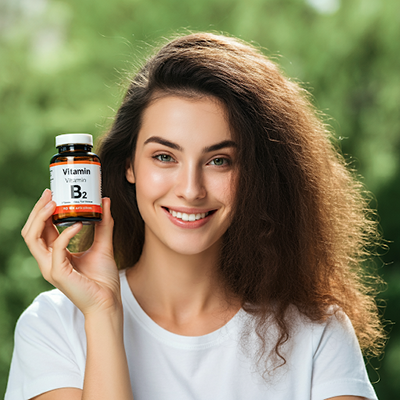
Aids carbohydrate metabolism; works with vitamin A and other B vitamins. Needed for growth, good eyes, nails, skin, and hair. Helps prevent certain cataracts. Important during pregnancy.
- Sources: The richest sources include torula yeast, brewer’s yeast, almonds, and wheat germ. Other good sources include whole grains, almonds, sunflower seeds, soybeans, cooked leafy vegetables, and milk.
- Deficiency symptoms: Eye problems: Itching, burning, sensitivity to light, bloodshot. Mouth: sore, cracking of the lips and corners of the mouth, burning and itching, lips, inflamed tongue. Oily or dull hair, oily skin, premature wrinkles on face and arms, split nails. Visual disturbances include sensitivity to light, loss of visual acuity, and cataract formation. Other disorders of the mucous membranes. Severe anemia, seborrheic dermatitis. Certain esophageal cancers.
- Needed for assimilation: Vitamin B complex, vitamin C.
- Uses: Crucial in the production of energy. Primarily used in treating migraine headaches, sickle-cell anemia, and cataracts (but for cataracts, do not use more than 10 mg daily).
- Cautions: Destroyed by light, but not by cooking.
- Toxicity: No toxicity or side effects, except cataract patients should not consume more than 10 mg daily.
- Interaction: Riboflavin works closely with thiamin.
- Dosage: RDA 1.6 mg/ ODA 50 mg/ TDA 200-500 mg.
- Recommended: 5-10 mg daily. The body cannot absorb more than 20 mg in a single dose.
Vitamin B3 (Niacin, Niacinamide, Nicotinic Acid)

Maintains and strengthens the gastrointestinal tract, circulation, nervous system, and skin. Needed for protein and carbohydrate metabolism. Intensifies blood flow to the skin and extremities. Good for cold feet and hands. Important in energy production and metabolism of fat, cholesterol, and carbohydrates. It helps the body produce many hormones. Used in over 50 different chemical reactions in the body. Helps regulate blood sugar and antioxidant mechanisms. Helps lower high cholesterol and reduce early-onset arthritis and diabetes. It is excellent for treating early diabetes (but should not be used for advanced cases).
- Sources: The richest sources include torula yeast, brewer’s yeast, rice bran, rice polishings, wheat bran, and peanuts. Other good sources include brown rice, wheat germ, sunflower seeds, green vegetables, and wheat products.
- Dosage: Niacinamide possesses many of the same effects as niacin, but for most purposes, it is better because it does not cause the flushing of the face, which niacin will induce for several minutes. Best use niacin amide to avoid face flush). RDA 18 mg/ ODA 100 mg/ TDA 2000-6000 mg (time release). Mega-doses are up to 25000 mg for schizophrenia, high cholesterol, and arteriosclerosis (but prolonged massive doses can induce stomach ulcers, jaundice, liver damage, colitis, and male impotence).
- Recommended: Take it with meals. Of patients given 1.5 grams daily of niacin for 26 weeks, 23 percent had lowered LDL (bad) cholesterol, and 33 percent had increased HDL (good) cholesterol. (However, some patients could not tolerate the face flushing.) Hundreds of patients with osteoarthritis and rheumatoid arthritis were given 900-4000 mg of niacin amide in divided doses daily and experienced good results.
- Needed for assimilation: Vitamin B complex, vitamin C.
- Interactions: The body converts tryptophan into niacin. Because niacin works closely with the other B vitamins, they all need to be taken at the same time.
- Warning: Do not use sustained-release niacin; it can damage the liver. (In one test, 52 percent taking it experienced liver damage). Instead, gradually increase regular pure crystalline niacin dosage over 4-6 weeks (from 100 mg 3 times daily to 1.5-3 grams daily in divided doses). Inositol hexaniacinate is the safest form of niacin currently on the market. Niacin should not be used in advanced diabetes or for those with pre-existing liver disease.
Vitamin B5 (Pantothenic Acid, Calcium Pantothenate)
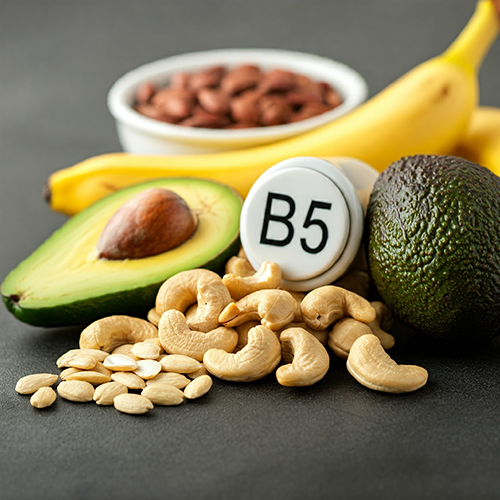
This vitamin stimulates metabolism and all life processes and promotes growth. Prevents graying and skin changes. Good for sunburn and skin burns. It may protect against skin cancer. Helpful in eczema and lupus. Helps absorption of folic acid. Increases cortisone and other adrenal hormone output. It is an anti-stress factor and helps the body resist the effects of stress, infection, and premature aging of skin organs. It allows one to recover more rapidly and protects against radiation effects.
- Sources: The richest sources include Brewer’s yeast torula yeast. Other sources include wheat bran, wheat germ, whole-grain products, molasses, milk, green vegetables, beans, peas, peanuts, crude molasses, yogurts, and egg yolks. Deficiency is rare since pantothenic acid is found in so many different foods.
- Uses: Used to treat adrenal function, rheumatoid arthritis, lower blood cholesterol and triglycerides levels.
- Deficiency symptoms: Anemia, eczema, extreme fatigue, infertility, reproductive problems, muscular weakness, stomach distress, constipation, chronic fatigue, tendency to infections, graying and loss of hair, retarded growth, painful and burning feet, insomnia, adrenal exhaustion, low blood sugar, muscle cramps, low blood pressure, skin disorders. Deficiency is one of the causes of asthma. Severe deficiency is shown by “burning foot syndrome” and possibly numbness and shooting pains in the feet.
- Interactions: Vitamin B complex, vitamins A, C, and E are needed for the assimilation of pantothenic acid. It is used in the manufacture of coenzyme A, and for ACP. Without this, fats and carbohydrates cannot be used for energy production. It is needed in the production of adrenal hormones and red blood cells.
- Cautions: It is possible that continuous ingestion of high doses can cause heart, kidney, and liver problems. Works with folic acid.
- Dosage: RDA 4 mg/ ODA 50 mg/ TDA 50-200 mg. Researchers have given 1000 mg daily for 6 months without side effects. Helps in the assimilation of many foods.
- Recommended: 250 mg daily. For rheumatoid arthritis, 2 grams daily. For lowering cholesterol and triglycerides, 300 mg daily.
Vitamin B6 (Pyridoxine)
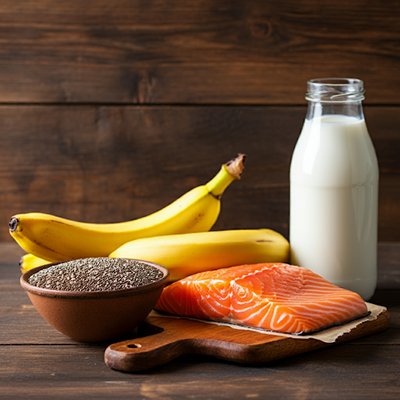
Pyridoxine is used in more body functions than almost any other vitamin. Needed for proper functions than almost any other vitamin. Needed for proper functioning of over 60 different enzymes. Extremely important in the formation of body proteins and structural compounds, red blood cells, chemical transmitters in the nervous system, and prostaglandins. Important in maintaining hormonal balance and proper immune function. Vital cell multiplication; hence in avoiding miscarriage. Parkinson’s has responded to B6 injections (in combination with magnesium). Vitamin B6 is required for the absorption of B12 and hydrochloric acid production. It is crucial for brain chemistry because it produces all amino acid neurotransmitters. Vital to over 100 health conditions, including asthma, autism, cardiovascular disease, carpal tunnel syndrome, Chinese restaurant syndrome, diabetes, depression, epilepsy, immune enhancement, kidney stones, nausea and vomiting during pregnancy, osteoporosis, and premenstrual syndrome.
- Sources: The best sources of this vitamin are torula yeast, brewer’s yeast, wheat germ, sunflower seeds, soybeans, lentils, and walnuts. Other sources include bananas, brown rice, peanuts, whole wheat, eggs, and avocados.
- Deficiency symptoms: Skin disorders, sore mouth and lips, anemia, edema, mental depression, halitosis, eczema, nervousness, kidney stones, insomnia, tooth decay, colon inflammation, migraines, premature senility.
- Needed for assimilation: Vitamin B complex, vitamin C, and potassium.
- Toxicity: This is one of the few B vitamins associated with some toxicity. Doses greater than 2000 mg daily can produce tingling sensations in the feet, muscle coordination loss, and nerve tissue degeneration. Therefore, limit the dosage to 50 mg daily.
- Interactions: Riboflavin and magnesium are necessary for the body to utilize pyridoxine. Riboflavin interacts with magnesium and zinc and helps their utilization. Food colorings, certain drugs, oral contraceptives, alcohol, and excess protein intake destroy riboflavin.
- Dosage: RDA 2.2 mg/ ODA 50 mg/ TDA 200-500 mg, combined with other B vitamins.
- Recommended: Therapeutic dosage is 50-100 mg daily, even for long-term use. If you use more than 50 mg daily, divide it into 50 mg doses (because the body can only absorb 50 mg at a time). In some instances, 25-50 mg daily reduces or eliminates epileptic seizures but must be strictly monitored. It should not be given with anti-seizure drugs. Pregnant women given 30 mg daily experienced significantly less nausea and vomiting. (Ginger root powder did about as well.) In another study, 72 percent of 106 young women taking 50 mg daily for one week prior to and during their period experienced a reduced premenstrual acne flare-up. Over a dozen other studies also produced lowered PMS symptoms.
Vitamin B12 (Cobalamin)
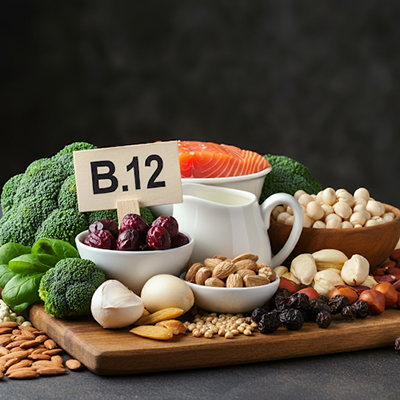
It is needed to produce red blood cells. It prevents anemia and promotes growth in children. B12 is especially used in the treatment of impaired mental ability in the elderly, asthma, diabetic neuropathy, depression, low sperm counts, multiple sclerosis, and tinnitus. (In order to absorb the small amounts of B12 found in food, the stomach secretes “insintric factor,” a special digestive secretion that increases its absorption in the small intestine.).
- Sources: B12 is present in vegetables in only small amounts. It is in forfeited brewer’s yeast, milk, and eggs. It can also be taken in a vitamin supplement. You need so little of it that it can generally be obtained from food sources.
- Deficiency symptoms: Chronic fatigue, numbness or stiffness, sore mouth, difficulty in concentrating. If there is enough B6 and cobalt, the body will make its own B12. Pernicious anemia is largely caused by B12 deficiency. Although the classic symptom of B12 deficiency is pernicious anemia, a lack of B12 affects the brain and nervous system first. This can result in numbness, pins-and-needles sensations, a burning feeling, or, in older people, a mimic Alzheimer’s effect. B12 deficiency is a major cause of depression in older people.
- Cautions: Be cautious about taking B12 if you have folate (folic acid) deficiency, iron deficiency, any kind of infection, Leber’s disease, polycythemia vera uremia. Otherwise, you are not likely to have problems with B12. If enough cobalt is in the body, the bowel can make its own B12. Unlike other water-soluble vitamins, B12 is stored in the liver, kidney, and other tissues. No one has ever reported toxicity from B12. There are two forms of B12. In clinical trials, methylcobalamin (the more active form) produces better results than cyanocobalamin.
- Interactions: B12 and folic acid work closely together and should be taken together. A lack of B12 causes melatonin to be undersupplied, resulting in inadequate sleep at night.
- Dosage: RDA 3 mcg/ ODA 200 mcg/ TDA 1000 mcg. It is difficult to assimilate therapeutic doses by mouth, so doctors generally give it by injection. A sublingual tablet, available in a health food store, can be placed under the tongue.
- Recommended: 2 mcg daily. For pernicious anemia, take 300-1000 mcg daily. Research shows that B12 taken orally (1000-2000 mcg daily) is just as effective as injections for pernicious anemia. (Ideal dosage: 2000 mcg daily for 1 month, followed by daily intake of 1000 mcg after that (Methylcobalamin is preferred over cyanocobalamin). Daily intake of 2000 mcg greatly improved 10 or 20 patients with asthma. Multiple sclerosis patients who were given 60 mg (not mcg) daily experienced significant improvement.
Vitamin B13 (Orotic acid)
Needed for synthesis by the body of nucleic acid. Used in treating multiple sclerosis. Helps cells regenerate.
- Dosage: Dosage not known.
- Sources: Whey protein of milk.
- Deficiency symptoms: Liver disorders, cell degeneration, and premature aging occur. Also, overall degeneration, such as multiple sclerosis.
Vitamin B15 (Pangamic acid, Calcium pangamate)
Helps regulate fat metabolism and stimulates glandular and nervous systems. Increases tolerance to insufficient oxygen supply. Used in treating angina, heart disease, blood cholesterol, premature aging, and impaired circulation. Given to people who have experienced carbon monoxide poisoning. Given to drunks to detoxify them.
- Sources: Whole grains, whole-brown rice, seeds and nuts.
- Dosage: Regular dose not known. A therapeutic dose is 100 mg daily: take 50 mg in the morning before breakfast and 50 mg at night. Used extensively in Russia and certain other countries. But not in America.
Vitamin B17 (Nitrilosides, Amygdalin; known as Laetrile when given as a medical dose for cancer)
Laetrile was discovered and developed by Drs. Ernst Krebs Sr. and Jr., of San Francisco, California, and is used in various countries in the treatment of cancer. Its other nutritional functions have not yet been fully examined.
- Sources: Most whole seeds of fruits and many grains and vegetables. Especially rich in apricot, peach, and plum pits; also, apple seeds, raspberries, cranberries, blackberries, and blueberries. Mung beans, lima beans, garbanzos, millet, buckwheat, and flaxseed. Deficiency of this factor may be unlikely if whole seeds, grains, nuts, and beans are eaten.
- Cautions: If you eat a bucketful of apricot pits each day, you could experience arsenic cyanide poisoning.
- Dosage: No set amount since it is not yet officially listed as a vitamin. Nutritional deficiency of this factor may be unlikely if whole seeds, grains, nuts, and beans are eaten. Therapeutic doses are given for the treatment of cancer.
B complex vitamins: Biotin

Needed for protein and fat metabolism and hair growth. Prevents hair loss. Has antiseptic qualities and has been used in the treatment of malaria. Increases the strength of nails.
- Sources – The richest sources include brewer’s yeast. Other sources include soy flower, soybeans, unpolished rice, rice bran, rice, germ, rice polishings, peanut butter, walnuts, pecans, oatmeal, other nuts, and whole grains.
- Deficiency symptoms – Dry, scaly skin. Dandruff, hair loss, and skin disorders, such as eczema and seborrhea. Nausea, anorexia. Pallor, loss of appetite, confusion, extreme fatigue, drowsiness, hallucinations. Lung infections, heart abnormalities, anemia. (The underlying cause of cradle cap in infants is biotin deficiency.)
- Needed for assimilation – Vitamin B complex, folic acid, pantothenic acid, vitamin B12, vitamin C.
- Caution – Biotin is extremely safe, and no one has reported side effects from overdose. Raw egg white includes avidin, a protein that binds biotin and prevents its absorption.
- Interactions – Biotin works closely with other B vitamins, coenzyme Q10, and carnitine. However, its absorption is damaged by alcohol and antibiotics.
- Dosage – RDA 200 mcg/ ODA 300 mcg/ TDA 500-3000 mcg.
- Recommended – 30-300 mcg daily. For cradle cap, give 3000 mcg daily to nursing mothers. (If not breastfed, give the infant 100-300 mcg daily.) For stronger nails and healthy hair, 1000-3000 mcg daily (in one study, 91 percent experienced improvement.)
B complex vitamins: Choline

Lecithin helps the body digest, absorb, and carry fat and fat-soluble vitamins in the bloodstream. It allows less fat and cholesterol to be deposited in the arteries and liver. Without it, the arteries become clogged, leading to hypertension and cardiac problems. Lecithin is essential for fat metabolism and synthesizing nucleic acids (DNA and RNA). Needed for the myelin sheaths of the nerves. Helps liver and gallbladder function. Needed for production of phospholipids. Essential for the manufacture of certain neurotransmitters and the proper metabolism of fats. Without it, fats become trapped in the liver, which blocks metabolism. Choline is extremely important in brain and memory function and helps treat Alzheimer’s.
- Sources: The richest sources of choline and inositol are abundant in lecithin, the richest source of both. However, egg yolks are equally rich. Blackstrap molasses is a rich source of both choline and inositol. Other sources include legumes, grains, and egg yolks, primarily as lecithin and lettuce). If a choline supplement is taken, it should be rich in phosphatidylcholine.
- Uses: Choline prevents gallstone formation, high blood pressure, atherosclerosis, kidney damage, nephritis, glaucoma, and myasthenia gravis. It is also used in the treatment of bipolar depression (manic depression). In Germany, choline is used to treat a wide variety of serious liver problems, and phosphatidylcholine is used to significantly lower total serum cholesterol and triglyceride levels and increase HDL cholesterol levels. (HDL is a good kind of fatty acid).
- Deficiency symptoms: Cirrhosis and fatty liver degeneration, atherosclerosis, high blood pressure, hardening of the arteries, and kidney damage.
- Cautions: Prolonged massive doses of choline (isolated and separated from inositol) may cause depletion of B6, especially inositol. (Lecithin is rich in both choline and inositol.) Not toxic under 6000 mg. Choline helps conserve carnitine and folic acid and works closely with inositol in carrying on physical functions.
- Dosage: RDA 150 mg/ ODA 600 mg/ TDA 500-1000 mg. Choline works closely with inositol in carrying out certain physical functions. Not toxic under 6000 mg.
- Recommended: Take a lecithin product, which has 90 percent phosphatidylcholine, 3 times daily with meals. For the treatment of liver disorders: 300-500 mg daily. To lower cholesterol: 500-900 mg daily. To treat Alzheimer’s disease and bipolar depression: 5000-10000 mg daily. Choline, in the form of phosphatidylcholine, is usually used to treat these diseases since it is more useable in the body.
B complex vitamins: Inositol
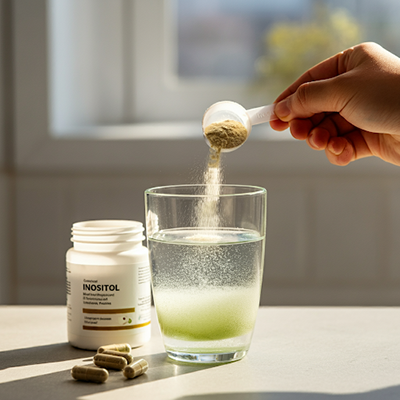
Inositol prevents hair thinning, and baldness increases hair growth. It is needed for the integrity of the heart muscle. Reduces blood cholesterol. Used in the treatment of schizophrenia and obesity, liver disorders, depression, and diabetes. Both choline and inositol are primary components of cell membranes. Like choline, inositol has a “lipotropic” effect; that is, it promotes the export of fat from the liver, which must occur, or the liver stagnates, and cirrhosis develops. It is used to treat a wide range of liver disorders. Very useful in treating depression.
- Sources: Both choline and inositol are abundant in lecithin, the richest source. One tablespoon of brewer’s yeast provides 40 mg each of choline and inositol. Blackstrap molasses is a rich source. Good plant sources include citrus fruits, whole grains, nuts, seeds, and legumes. Wheat germ, bulgar wheat, brown rice. When phytic acid in some plant sources is eaten, intestinal bacteria change some of it into inositol. (Phytic acid itself helps protect the body against cancer.)
- Deficiency symptoms: Eczema, eye abnormalities, high blood cholesterol, hair loss, constipation.
- Needed for assimilation: Vitamin B complex and C.
- Side effects: There are no side effects to inositol.
- Dosage: RDA 75 mg/ ODA 100 mg/ TDA 500-2000 mg. Frequently said to be the same dosage as for choline.
- Recommended: 100-500 mg daily for general liver support. 1000-2000 mg daily to treat diabetes. Twelve grams daily for depression or panic disorder.
B complex vitamins: Folic acid

Folic acid works with B12 in forming red blood cells. Needed for RNA and DNA production, cell growth and division, protein metabolism, healing process, skin and hair health. Helps prevent graying hair and builds antibodies to fight infection. Needed in dropsy, diarrhea, menstrual problems, and stomach ulcers. Also, atherosclerosis, anemia, radiation burns, circulation problems, and sprue (tropical anemia and diarrhea).
- Sources: The richest sources include brewer’s yeast. Other good sources include blackeye peas, rice, germ, soy flour, wheat germ, wheat bran, various beans, Deep green leafy vegetables, white potatoes, nuts, and peanuts. There are excessive concentrations of it in green, leafy vegetables.
- Deficiency symptoms: Impaired circulation, hair loss, serious skin disorders, grayish-brown skin pigmentation, megaloblastic anemia of pregnancy, and mental depression. Reproductive problems such as difficult labor, spontaneous abortion, and high infant death rate. Without folic acid, cells do not split properly. It is crucial for the development of the nervous system of the fetus. Deficiency during pregnancy is linked to several birth defects, comprising neural tube defects like spina bifida. Because meat is such a poor source, meat eaters are especially likely to develop deficiency symptoms. A lack of folic acid increases homocysteine in the body, which leads to atherosclerosis and osteoporosis. Inadequate folic acid is also involved in the following health problems: acne, AIDS, anemia, atherosclerosis, cancer, candida, canker sores, cataracts, celiac disease, cervical dysplasia, constipation, Crohn’s disease, diarrhea, epilepsy, fatigue, gout, hepatitis, infertility, Parkinson’s disease, periodontal disease, restless leg syndrome, seborrheic dermatitis, senility, ulcerative colitis. However, the principal use of folic acid is in the prevention or treatment of neural tube defects, atherosclerosis, osteoporosis, and cervical dysplasia.
- Cautions: Some authorities believe folic acid should not be taken during leukemia and cancer. Folic acid works intently with vitamin B12 and should always be taken with that vitamin. This is because folic acid can mask a B12 deficiency, resulting in nerve damage. Folic acid can disguise a B12 deficiency, resulting in nerve damage. Light, heat, drugs, estrogens, barbiturates, and alcohol destroy folic acid. High-dose folic acid should not be given to people with epilepsy because it occasionally increases seizure activity.
- Dosage: RDA 400 mcg/ ODA 1000 mcg/ TDA 20 mcg. Use this amount only with a prescription for osteoporosis). (0.4 mg is the normal amount. Therapeutic amounts to correct anemia are 5 mg or more. Unfortunately, potencies higher than 0.1 mg (100 mcg) in one tablet are available only by prescription. Physicians usually prescribe 5-10 mg daily. But it has proven safe in larger amounts if given with B complex or brewer’s yeast, and B12.)
- Recommended: 400 mg daily for general use and prevention of atherosclerosis and osteoporosis. 10 mg daily for treatment of cervical dysplasia and depression. In the U.S., 1-2 babies per 1000 have neural tube defects, yet 400 mcg given daily in early pregnancy would reduce this by 58 percent – 80 percent. When 1-2.5 mg daily is given, elevated homocysteine levels are significantly reduced. Yet high levels are a significant cause of heart attack or stroke. 10 mg daily normalizes pap smears, reducing cervical dysplasia. (Note: FDA restricts folic acid in supplements to 400 mcg., so significantly larger therapeutic doses require a prescription.)
B complex vitamins: PABA (Para-Aminobenzoic Acid)
Needed for body growth, metabolism, and all physical functions. Used in combination with pantothenic acid, choline, and folic acid to treat graying of hair and skin changes. When added to salve, it protects against sunburn and cancer. (It does this by absorbing ultraviolet-B (UVB) radiation.) It can also be put on burns. Useful in treating various skin disorders, including lupus and eczema. It helps protect against ozone, other air pollutants, and secondhand tobacco smoke. It reduces arthritic inflammation and increases joint flexibility. It keeps the skin healthy and delays wrinkling.
- Sources: Brewer’s yeast, whole-grain products, wheat germ, molasses, milk, yogurt, deep greens, and eggs.
- Deficiency symptoms: Anemia, gray hair, infertility, extreme fatigue, reproductive problems, and patchy areas of white skin (vitiligo).
- Needed for assimilation: Vitamin B complex, folic acid, vitamin C.
- Cautions: Some authorities suggest that continuous ingestion of PABA can injure the heart, liver, and kidneys. Sufa drugs block its absorption.
- Dosage: ODA 50 mg. Potencies of PABA higher than 30 mg per tablet are only available by prescription. Yet much higher doses are used, up to several hundred mg.
HEALTH DISCLAIMER: The information on this website is for educational uses only and is not a substitute for professional medical advice. Always consult an authorized healthcare provider for any health concerns before using any herbal or natural remedy. We do not establish, treat, cure, or prevent any disease. Reliance on any material from this website is solely at your own risk. We are not responsible for any adverse effects resulting from the use of information or products mentioned on this website.
REFERENCES
Vance Ferrell, Harold M. Cherne, M.D. 2010. The Natural Remedies Encyclopedia. Altamont : Harvestime Books, 2010. pp. 100, 101, 102, 103, 104, 105. Vol. Seventh.
